Deployments - New London |
| |
 |
| New London Naval Submarine Base - on the Thames River, on the coast of Connecticut |
| |
| The original Naval Station Groton was a mile long patch of land some 700 feet wide along the Thames River just across from the City of New London. Some additional land and facilities were also available in New London suitable for administration and other support buildings - should the facility at Groton ever grow to need such. However - in the first roughly 50 years that the station had been available to - and used by the military - it had yet to prove it's value to the military. One of the original uses for the Station that had been envisioned many, many years prior by many naval experts - including John Paul Jones -- was as a national depot for building, repair and safekeeping of America's Naval Fleet. Of course since the late 1700's the country and it's navy had grown far too large for a single facility to accomplish all of those things. However - many of the Navy's largest and most famous civil war era ships - such as the USS Nevada, USS Severn and USS New Hampshire had been indeed stored at Groton - with New Hampshire serving as Station Receiving ship into the late 1890's. However - as ships got larger - and the technology they used grew - so did the requirements for the ship's bases - and there were other bases better suited for the growing number of ever larger and complex ships. In the early 1900's the Navy built facilities to store and load coal. With the transition from sail to steam - the Navy needed better ways of handling coal. However - coal was soon replaced by oil - either burned in boilers rather than coal - or in the new internal combustion engines that were coming on line. The result was that the expected demand for the coaling station at Groton never materialized. By 1912 - the Navy was ready to rid itself of the base - such that it's disposal was part of the Navy's 1912 Appropriations Bill. However - intervention by Connecticut's Representative Edwin Higgins save the base - so now - like it or not - once again the Navy needed to find a mission for this facility. Sometime in early 1913 someone had a grand idea: take a bunch of boats that few in high command wanted (submarines) - stick them at a base that has a history - if not of outright failure - of at least not being a success -- and perhaps they'll "sink" together! On October 13,1915 the monitor Ozark - a submarine tender - and five submarines - SS-17 (D1), SS-18 (D2), SS-19 (D3), SS19.5 (G1) and SS-27 (G2) arrived at the Naval Station Groton, Connecticut - and set up shop - providing a "yet another chance" for the facility to prove to the Navy it was worth keeping. |
| |
 |
| USS Ozark and four submarines at New London in 1915 |
| |
| Within a month - Fulton (AS-1) arrived with more submarines - and the activity of submarine service began in earnest. By 1916 - enough infrastructure and command facilities were in place that the first base commanding officer was assigned - Commander Yates Stirling - in command of the New London Flotilla, the base proper - and the newly established submarine school. |
| |
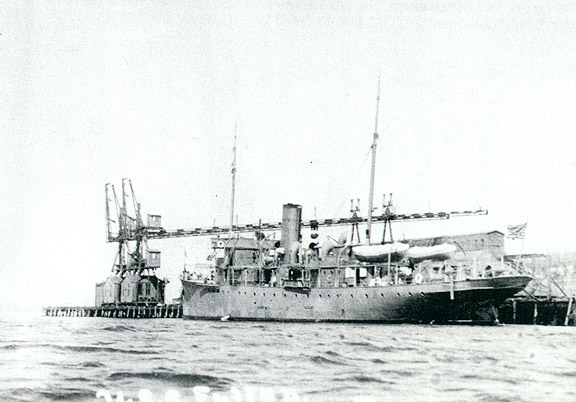 |
| USS Fulton (AS 1) at New London just before World War I. |
| |
| One of the early failures at Groton was that a training facility had been proposed for the base - but before being completed - the large facility was relocated to Newport instead. The buildings and facilities started for the project were not completed - but did serve some time as a Marine training facility. Once the Submarine Base became active - these facilities were put to use - and quickly expanded for training Submarine Crews. The proximity to Electric Boat provided a synergy that helped to bring many of the greatest experts in Submarine technology to the area - helping establish the region as the boat capitol of the country. As the new century progressed into the teens - tensions in Europe started to become of concern in the United States. While wishing very much to remain neutral - and "stay out of it" - many people realized early on that prudent course of action would be to quietly prepare - just in case. By the time open conflict broke out - the United States was well along in seeing to the readiness of our ships, crews, supplies and support facilities. In the case of New London - while there were some facilities (buildings, piers, etc.) there - the needs far surpassed the available resources - and as the war flamed ever closer - those needs became urgent. The Navy needed an "instant base". While that may seem impossible - the Navy was - by the outbreak of World War I - getting used to the idea that a tender was a base just as soon as she dropped anchor. |
| |
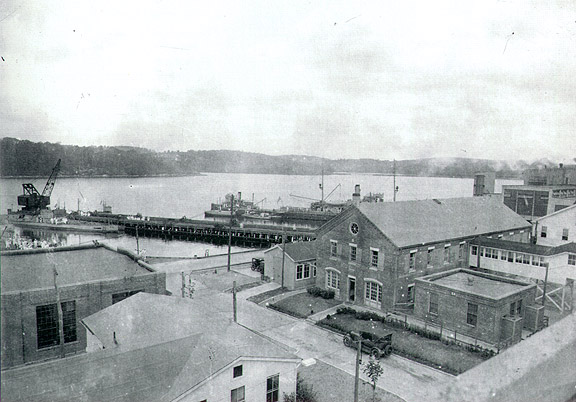 |
| Sub base growing in the early years. Still - looks like a tender at the pier... |
| |
| Several specialty schools were established - many are still active in training the all volunteer submarine crews. Just during World War I alone - the base went from a couple of small brick buildings to over 80 - many still standing and in use today. Submarines and submarine sailors are very different from surface ships and surface sailors. Surface sailors - because of their numbers and their ships - have the "luxury" of specializing in a relatively narrow field of training and work. Submariners - however - because of the much smaller crews - and the incredible complexity of submarines - must become even more than "jack-of-all-trades" - they must in fact become masters of many fields and skills - as their very survival depends on their knowledge and their skills. Submarine School New London makes an excellent starting point for potential submariners - teaching systems concepts as well as basic skills that will become second nature to those who pass the school. And certainly - not all who go to Sub school pass - it is also a time for the Navy - those sailors who conduct the classes, etc. to evaluate those candidates and winnow out those that for one reason or another seem not to be well suited to Submarine duty. Yet - in spite of all of the buildings and facilities constructed - for most of Submarine Base New London's history - there has been a "permanent" tender assigned to accomplish much of the repair, supply and support needs of the submarines that come to port. One of the reasons is that this has allowed the shore facilities to concentrate on two areas - training and depot maintenance - that shore facilities can do very well. The tender taking care of intermediate level maintenance and urgent repair needs. |
| |
 |
| |
| After "the War to End All Wars" was over - the United States Navy took some time to re-evaluate the submarine. The German Navy had proven that the boats could be used very effectively as an offensive weapon - so the United States Navy - taking the lessons learned - began to re-design it's submarine fleet from the keel up - so no new construction was started. Cessation of hostilities also meant a service wide slow-down in activities - including at the Naval Submarine Station, New London. However - this time - the base had a mission to continue working on. One of the great problems with submarines was their safety- or lack of it - and rescue - or the lack of means for that, either. When a surface ship is damaged - either in combat or some other cause - the crew usually has the ability to address the situation and save the ship - or abandon it if it's lost. Problems aboard a submarine are far less forgiving - and the depths they operate at make "abandoning ship" problematic - if not impossible without special equipment. This was the mission that busied those at New London. Experimental work was started on emergency escape, rescue, salvage and repair equipment and procedures that would soon save lives. The 100 foot tall escape training tower was completed and operational by 1930. |
| |
 |
Left - the 100 foot escape training tower. Top right: pressure chamber is used to test every sailor's ability to adjust to pressurization and decompression. This test must be passed before they attempt an assent in the escape tower. Bottom right: instructors guide a sailor through the access hatch into the tower to make his assent. |
| |
| During this period - many additions and improvements were made to the base. The submarine school at San Pedro was closed and consolidated to New London enlarging that mission. That and other additions, improvements, etc. continued - such that by the mid 1930's - New London no longer needed a permanent tender deployed - so Camden which had served as the resident tender from 1923 left in 1931. But things aren't always "obvious" - the submarine rescue and salvage ship Falcon soon found herself filling not only her primary mission - but as tender as well. She was very active in New London's research and development of new submarine search, rescue and salvage - as well as being an ever present safety ship for new submarines undergoing diving tests and other acceptance testing. Operating out of New London - she worked with submarines from Maine to the Panama Canal. |
| |
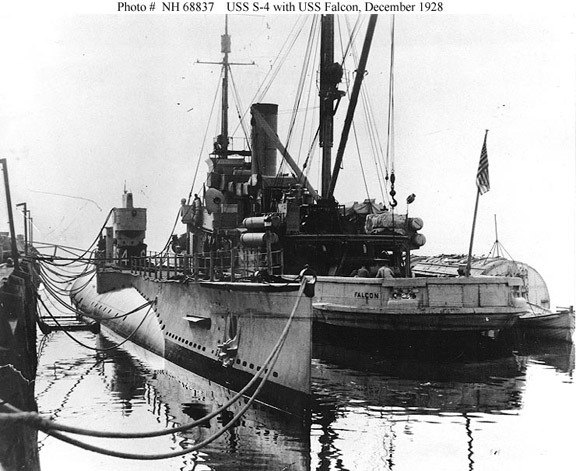 |
| |
| Then the grumbling of war rose once again. And once again - the Navy saw a need at New London - so the tender Beaver was deployed there as tender to Submarine Squadron 7. The squadron served mainly as coastal defense against German raiders until December 1942 when they were sent to Europe. For the remainder of the War - New London's efforts were concentrated on training (now acknowledged as the premier submarine training facility in the world), development and production of torpedoes as well as supporting patrols in the North Atlantic. |
| After World War Two - once again the notion that peace meant that the military should be stood down became popular - and indeed huge numbers of military assets were dismantled and disposed. The Navy decided that it didn't want to scrap it's submarine fleet - at least not right away. But what do you do then with 50+ submarines? New London was overwhelmed. No place to dock them - inadequate facilities to handle that many boats. Solution? Sure - instant sub base - the tender. Four of them at first - though that was reduced to three by February 1946. - The "New London Group" of the16th Reserve Fleet was headed up by the tender USS Apollo (AS 25) with assistance from USS Anthedon (AS 24) and later USS Proteus (AS 19). These tenders processed the submarines for storage - cleaning, sealing with preservatives- making sure that the boats could withstand being stored "on the water" without being ravaged too severely. This process took a couple of years. By the end of the 50's - most boats had indeed been scrapped - as the technology of the newer boats soon made them obsolete. |
| |
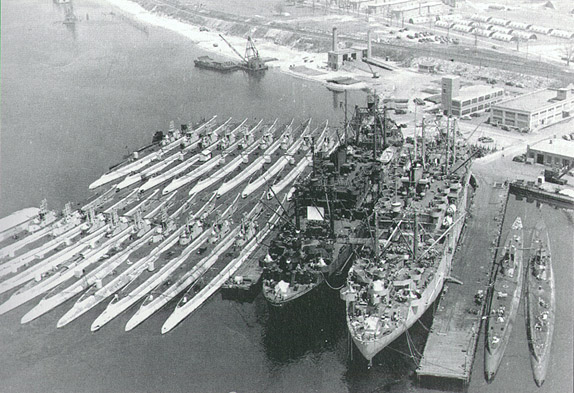 |
| The 16th Reserve Fleet, New London 1946 |
| |
| Apollo was "decommissioned" but "in service" at New London until approximately 1963. USS Proteus was also decommissioned but "in service" at New London from September 1947 until January 1959 when she was sent to Charleston for conversion. As the after the war rush calmed down - it might seem that New London would once again find itself without the need for a permanent tender - yet indeed - Fulton was deployed at New London - as there was a "new need" - nuclear capability. By 1958 Fulton's brood also included the Sea Wolf, the Skate, and the Nautilus - making Fulton the first Tender to support nuclear Fast Attack Subs. With the "cold war" now getting hotter - submarine technology was growing at an unprecedented rate - and the flexible tender was needed to keep pace. Although Fulton's primary assignment was as tender for Submarine Squadron 10 at New. London, on occasion she would relieved the tender Orion (AS-18), stationed at Norfolk, and also left New London for exercises from Newfoundland and Iceland to the Caribbean. For 20+ years - Fulton was a "fixture" at New London Submarine Base. With the increasing threat from the Soviet Union - the Cold War escalated into the 60's. The Soviet's "demonstration" of their ICBM's capabilities "stunned" the western world - with nothing in the United States defensive arsenal with which to counter the threat. With the United States now leading in one technology - the nuclear powered submarine with it's obvious advantages - it became the ideal platform on which to build a defensive system. An early nuclear submarine USS Scorpion - SSN 589 - which was well along in construction was cut in half - lengthened to accommodate missile tubes and support systems - and became the USS George Washington - SSBN 598 - the United States first deterrent missile submarine - or FBMs. |
| |
 |
| A rare historic moment in time. February 18, 1961, State Pier, New London. As noted - USS Scorpion SSN 589 was cut in half to allow for the installation of 16 missile tubes, and the additional support equipment for navigation, guidance, maintenance and launching of those missiles. This allowed the United States to respond a couple years sooner to the new Soviet Threat of their recently demonstrated Intercontinental Missiles. However - getting SSBNs to sea was only part of the "need". These boats - to be deployed to the Eastern Atlantic - would need a Tender on site for refits. While Hunley was under construction (designed and built from the keel up as an SSBN tender) - she too would take too long to answer the threat. So it was that USS Proteus (AS-19) was moved from New London to Charleston where she too was cut in half and had a 44 foot section added to her which contained missile storage tubes, and additional shop spaces to service the new SSBNs. Still one more piece was missing. Since the tender was to be deployed at great distance from home - she would need to be re-supplied - and since part of those supplies would be missiles - a supply ship was also converted to carry the new weapon system and components. Here in this one picture are all three elements together for the first time - the fist upkeep of the USS George Washington SSBN 598 after her first successful deterrent patrol - by USS Proteus. On the other side of State Pier is USS Alcor AK-259 - who had just brought up a supply of Polaris missiles from Goose Creek- and successfully transferred them to USS Proteus. We noted that this was a particularly historic photo - and so there is one more thing: Notice the submarine moored just forward of Proteus' bow. That is the "new" USS Scorpion - SSN 589 - which was lost at sea just a little over 7 years later in one of the worst submarine accidents in United States Submarine history. |
| |
| As more and more FBMs came on line - the Soviets first countered with Fast Attack Submarines to try to find and neutralize the United States FBMs - then later building and deploying FBMs of their own. The United States countered with more Fast Attacks - some designed as hunter-killers of other Fast Attacks - and some more specialized as hunter-killers of FMBs. New London served as the nerve center of all of this submarine activity - the largest Submarine Base in the world. |
| |
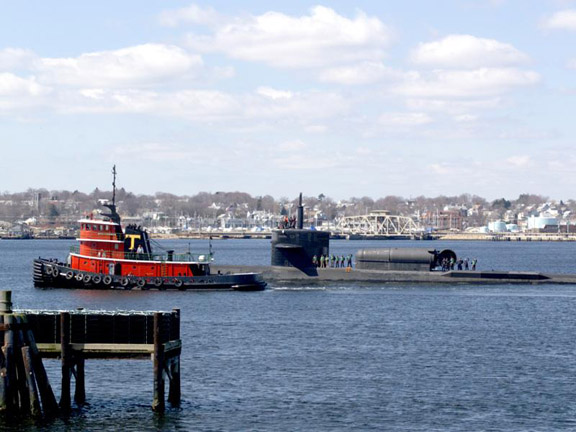 |
| One of our "hunter killers" coming into New London - USS Dallas SSN 700 |
| |
| It's now 2006 - and New London is once again - "overwhelmed". Studies and reports indicate that the draw-down of the military through reduced budgets, etc. has severely affected New London's ability to provide adequate maintenance to the submarine fleet home ported there. First the physical size of the base - there just isn't much - if any - room to expand. . Many of the buildings are pre-World War Two - and it has been joked that heating some of them takes more gold out of Fort Knox than Goldfinger tried to steal. The problem is - with no more to expand - they have to demolish a building in order to have room to build a new one. What then - do you do with that building's tenants during construction? There aren't enough cranes - and what few cranes there are run by civilians that "like" to work 8 hundred hours to 16 hundred hours - five days a week. Nights, weekends and holidays are incredibly expensive with overtime (not to mention the grousing that is often heard). Under the new maintenance management system - the squadron no longer controls it's own maintenance facilities nor crews - they now compete for limited resources - which at times means some systems aboard the boats aren't fixed as timely nor cost effectively as they used to be. The Navy is well aware of these problems - and they came up with a solution - which was to close the base and relocate the boats and various support commands to other bases. This was the New London portion of the Navy's 2005 BRAC proposal. However - the BRAC panel rejected the Navy's plans - and the Navy is "stuck" trying to figure out how to "fix" New London. The following is an opinion / editorial by the webmaster. The opinions expressed are his alone; and do not reflect those of the United States Navy, it's command nor other personnel. Is there a solution? YOU BET - at Inactive Ships - several tenders are there - USS Simon Lake (AS 33), and USS McKee (AS 41 - and our newest tender) -- either of which could be back in service in short order. Fully manned - one tender at New London could relieve much of the work "overload" at New London. TWO tenders deployed to New London could off-load enough work from the base to allow for a complete, and well executed "overhaul" of the entire complex. New London benefited from a permanent tender's presence for most of it's history as a Submarine Base. During those times New London's support of submarines was reported to be outstanding. Perhaps it's time to put one (or more) of our "inactive" tenders back to work - I'm certain Lake, Spear and/or McKee could once again make a significant contribution to our nation's defense. |
| |
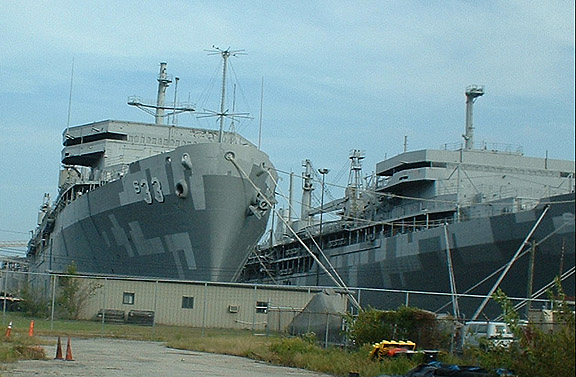 |
| USS Simon Lake (AS 33) and USS KcKee (AS 41) at inactive ships St. Juliens Creek facility - just itching to get back to work. Is there any chance the Navy will "see the light"? |
| Go Back to Deployments - PNS Portsmouth | Continue on to Deployments - San Pedro |
| Return to TenderTale Main Page © 2006 Common Cents Computers | |